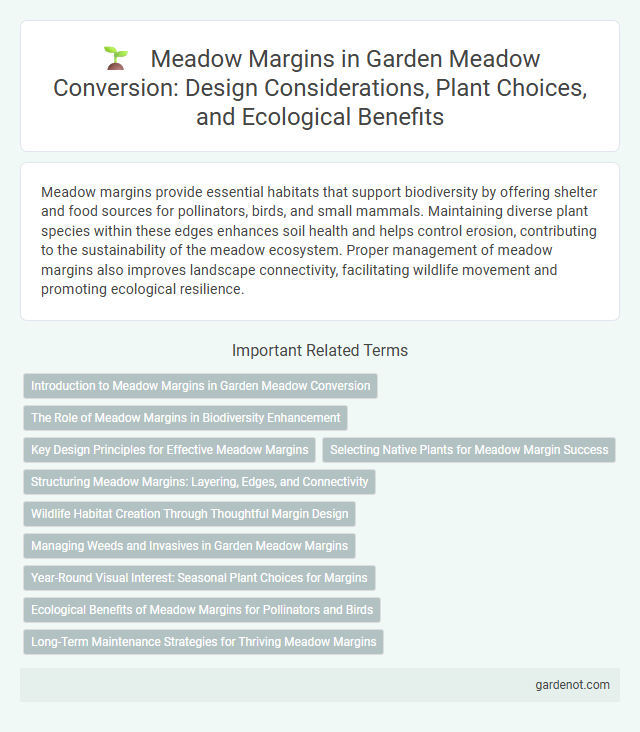Meadow margins provide essential habitats that support biodiversity by offering shelter and food sources for pollinators, birds, and small mammals. Maintaining diverse plant species within these edges enhances soil health and helps control erosion, contributing to the sustainability of the meadow ecosystem. Proper management of meadow margins also improves landscape connectivity, facilitating wildlife movement and promoting ecological resilience.
Introduction to Meadow Margins in Garden Meadow Conversion
Meadow margins serve as vital transitional zones between cultivated garden areas and wildflower meadows, enhancing biodiversity by providing habitats for pollinators, birds, and beneficial insects. Establishing meadow margins involves selecting native grasses and flowering plants that complement the meadow species, promoting ecological balance and soil health. These margins also act as natural buffers, reducing soil erosion and improving water retention, which supports the overall sustainability of garden meadow conversion projects.
The Role of Meadow Margins in Biodiversity Enhancement
Meadow margins serve as critical buffers supporting a diverse range of flora and fauna, enhancing ecosystem biodiversity by providing habitats for pollinators like bees and butterflies. These edges facilitate natural pest control by attracting predatory insects and improve soil health through increased organic matter and microbial activity. Integrating meadow margins in agricultural landscapes significantly boosts species richness and contributes to ecological balance.
Key Design Principles for Effective Meadow Margins
Effective meadow margins prioritize biodiversity by incorporating native wildflower species that support pollinators and local wildlife. Design principles emphasize structural diversity, ensuring varied plant heights and densities to create microhabitats for insects, birds, and small mammals. Proper edge management with gradual transitions between meadow and adjacent land enhances ecosystem connectivity and reduces invasive species encroachment.
Selecting Native Plants for Meadow Margin Success
Selecting native plants for meadow margin success enhances biodiversity by providing essential habitats for pollinators and wildlife. Native species such as wildflowers, grasses, and shrubs are well-adapted to local soil and climate conditions, ensuring lower maintenance and higher survival rates. Incorporating diverse plant heights and bloom times supports ecosystem resilience and continuous food sources throughout the seasons.
Structuring Meadow Margins: Layering, Edges, and Connectivity
Structuring meadow margins involves creating layered vegetation zones that provide diverse habitats for pollinators and wildlife, enhancing biodiversity. Well-defined edges between meadows and adjacent land uses promote ecological connectivity, supporting species movement and resource access. Integrating native shrub layers and flowering plants within these margins maximizes ecosystem services like soil stabilization and pest control.
Wildlife Habitat Creation Through Thoughtful Margin Design
Meadow margin design plays a crucial role in wildlife habitat creation by providing diverse plant species that support pollinators, birds, and small mammals. Incorporating native wildflowers, grasses, and shrubs enhances food availability and shelter, promoting biodiversity and ecosystem resilience. Thoughtful margin management, including staggered mowing schedules and pesticide-free zones, further sustains habitat quality and fosters long-term wildlife populations.
Managing Weeds and Invasives in Garden Meadow Margins
Garden meadow margins require targeted management to control weeds and invasive species that can outcompete native plants and reduce biodiversity. Employing selective mowing, hand-pulling, and the use of native ground covers helps maintain ecological balance while preventing the spread of aggressive weeds. Consistent monitoring and adaptive management practices ensure meadow margins support pollinators and promote a healthy, sustainable ecosystem.
Year-Round Visual Interest: Seasonal Plant Choices for Margins
Selecting a diverse range of perennial grasses, wildflowers, and evergreen shrubs ensures year-round visual interest on meadow margins by providing a dynamic display of colors and textures through each season. Incorporating species like native Sedum, Heuchera, and ornamental grasses such as Miscanthus creates structural variety that remains attractive from early spring blooms to autumn seed heads and winter foliage. Strategic planting of early-flowering bulbs alongside late-blooming asters extends the temporal appeal, supporting pollinators and enhancing biodiversity across multiple seasons.
Ecological Benefits of Meadow Margins for Pollinators and Birds
Meadow margins provide vital ecological benefits by supporting diverse pollinator populations such as bees, butterflies, and hoverflies, which are essential for plant reproduction and ecosystem health. These habitats offer abundant nectar sources and shelter, enhancing pollinator survival rates and facilitating bird species that feed on insects and seeds. Preservation and creation of meadow margins contribute significantly to biodiversity conservation and promote resilient agricultural landscapes.
Long-Term Maintenance Strategies for Thriving Meadow Margins
Long-term maintenance strategies for thriving meadow margins emphasize periodic mowing and selective grazing to prevent scrub encroachment and promote biodiversity. Soil health monitoring and adaptive planting of native wildflowers enhance ecological stability and support pollinator populations. Implementing rotational management ensures sustained habitat quality and resilience against climate variations.
Meadow margin Infographic

 gardenot.com
gardenot.com